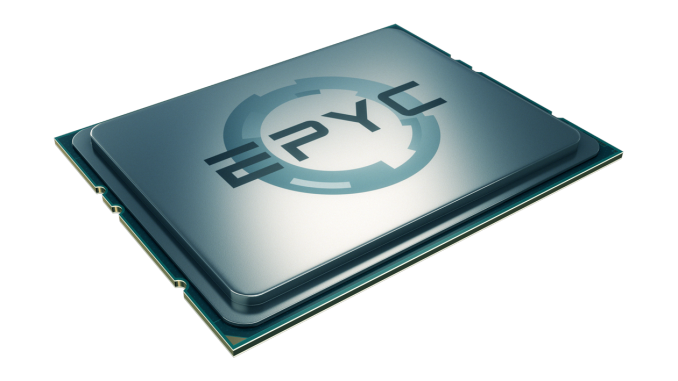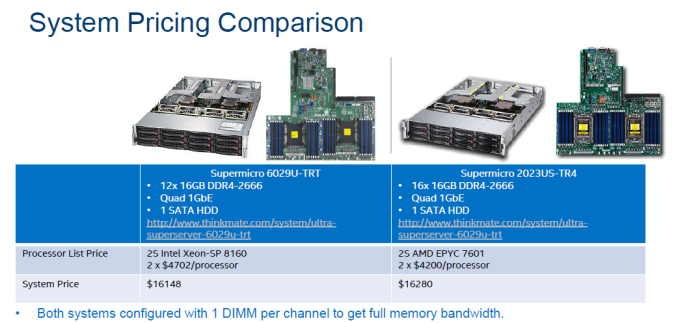Dissecting Intel's EPYC Benchmarks: Performance Through the Lens of Competitive Analysis
by Johan De Gelas & Ian Cutress on November 28, 2017 9:00 AM EST- Posted in
- CPUs
- AMD
- Intel
- Xeon
- Skylake-SP
- Xeon Platinum
- EPYC
- EPYC 7601

Although the AMD EPYC is definitely a worthy contender in the server space, AMD's technical marketing of the new CPU has been surprisingly absent, as the company not published any real server benchmarks. The only benchmarks published were SPEC CPU and Stream, with AMD preferring for its partners and third parties to promote performance. And, as our long-time readers know, while the SPEC CPU benchmarks have their merits and many people value them, they are a very poor proxy of most server workloads.
In every launch, we expect companies to offer an element of competitive analysis, often to show how their platform is good or better than the rest. At the launch of Intel's latest Xeon-SP platform, analysis to EPYC was limited to a high-level, as the systems were not as freely available as expected. AMD was able to do so on Broadwell-E at the time of the EPYC announcement because it was out and available - Intel wasn't able to do it on EPYC because AMD were several months away from moving it from a cloud-only ramp up program. This is partly the effect of AMD's server market implementation and announcement roadmap, although it didn't stop Intel from hypothesising about the performance deficits in ways that caught the attention of a number of online media.
Throughout all of this, AMD could not resist but to continue to tell the world that the "EPYC SoC Sets World Records on SPEC CPU Benchmarks". In the highly profitable field that is server hardware, this could not be left unanswered by Intel, who responded that the Intel Xeon Scalable has great "momentum" with no less than 110 performance records to date.
Jumping to the present time, in order to to prove Xeon-SP dominance over the competition, Intel's data center engineering group has been able to obtain a few EPYC systems and has started benchmarking. This benchmarking, along with justifications of third-party verification, was distributed to the small set of Xeon-SP launch reviewers as a guide, to follow up on that high-level discussion some time ago. The Intel benchmarking document we received had a good amount of detail however, and the conference call we had relating to it was filled with some good technical tidbits.
Our own benchmarks showed that the EPYC was a very attractive alternative in some workloads (Java applications), while the superior mesh architecture makes Intel's Xeon the best choice in other (Databases for example).
A Side Note About SPEC
A number of these records were achieved through SPEC. As mentioned above, while SPEC is a handy tool for comparing the absolute best tweaked peak performance of the hardware underneath, or if the system wants to be analysed close to the metal because of how well known the code base is, but this has trouble transferring exactly to the real world. A lot of time the software within a system will only vaguely know what system it is being run on, especially if that system is virtualised. Sending AVX-512 commands down the pipe is one thing, but SPEC compilation can be tweaked to make sure that cache locality is maintained whereas in the real-world, that might not be possible. SPEC says a lot about the system, but ultimately most buyers of these high-end systems are probing real-world workloads on development kits to see what their performance (and subsequent scale-out performance) might be.
For the purposes of this discussion, we have glossed over Intel's reported (and verified over at SPEC.org) results.
Pricing Up A System For Comparison
Professionals and the enterprise market will mention, and quite rightly, that Intel has been charging some heavy premiums with the latest generation, with some analysts mentioning a multiple jump up in pricing even for large customers, making it clear that the Xeon enterprise CPU line is their bread and butter. Although Intel's top-end Xeon Platinum 8180 should give the latest EPYC CPU a fit of trouble thanks to its 28 Skylake-SP cores running at 2.5 to 3.8 GHz, the massive price tag ($10009 for the standard version, $13011 for the high-memory model) made sure that Intel's benchmarking team had no other choice than also throwing in a much more modest Xeon Platinum 8160 (24 cores at 2.1 - 3.7 GHz, $4702k) as well as the Xeon Gold 6148 (20 cores at 2.4-3.7 GHz, $3072).
| SKUS Tested | |||||
| Intel Xeon Platinum 8180 |
Intel Xeon Platinum 8160 |
Intel Xeon Gold 6148 |
AMD EPYC 7601 |
||
| Release Date | Early Q3, 2017 | Late Q2, 2017* | |||
| Microarchitecture | Skylake-SP with AVX-512 | Zen | |||
| Process Node | Intel 14nm (14+) | GloFo 14nm | |||
| Cores / Threads | 28 / 56 | 24 / 48 | 20 / 40 | 32 / 64 | |
| Base Frequency | 2.5 GHz | 2.1 GHz | 2.4 GHz | 2.2 GHz | |
| Turbo | 3.8 GHz | 3.7 GHz | 3.7 GHz | 3.2 GHz | |
| L2 Cache | 28 MB | 24 MB | 20 MB | 16 MB | |
| L3 Cache | 38.5 MB | 33.0 MB | 27.5 MB | 64 MB | |
| TDP | 205 W | 150 W | 150 W | 180 W | |
| PCIe Lanes | 48 (Technically 64 w/ Omni-Path Versions) | 128 | |||
| DRAM | 6-channel DDR4 | 8ch DDR4 | |||
| Max Memory | 768 GB | 2048 GB | |||
| Price | $10009 | $4702 | $3072 | $4200 | |
As a result of this pricing, one of the major humps for Intel in any comparison will be performance per dollar. In order to demonstrate that systems can be equivalent, Intel offered up this comparison from a single retailer. Ideally Intel should have offered multiple configurations options for this comparison, given that a single retailer can intend for different margins on different sets of products (or have different levels of partnership/ecosystem with the manufacturers).
Even then, price parity could only be reached by giving the Intel system less DRAM. Luckily this was the best way to configure the Intel based system anyway. We can only guess how much the benchmarking engineers swore at the people who set the price tags: "this could have been so much easier...". All joking apart, the document we received had a good amount of detail, and similar to how we looked into AMD's benchmarking numbers at their launch, we investigated Intel's newest benchmark numbers as well.











105 Comments
View All Comments
Topweasel - Tuesday, November 28, 2017 - link
Yeah I want to give them the benefit of the doubt and I have no problem with them posting numbers even as analyzation of Intel in regards to EPYC. But a full page "review" of Intel's Epyc benchmarks as a product is kind of schilly. I mean where is their tests to back up the information? Where are the counterpart test where they test something similar that wasn't handpicked by Intel. How can any company assess the validity of a product based solely off of it's competitors testing of the product?bmf614 - Tuesday, November 28, 2017 - link
If you could actually get ahold of Epyc they would probably review the hardware themselves but as of yet it is a paper launch.supdawgwtfd - Wednesday, November 29, 2017 - link
It's not a paper launch dipshit.They can bearly keep up with orders for large companies.
Ryan Smith - Wednesday, November 29, 2017 - link
To throw some context in here, the purpose of this article isn't to publish Intel's benchmarks. Rather, it's commentary on what has been a very unusual situation.Up until now, neither AMD nor Intel have engaged in any serious Skylake Xeon vs. Zen EPYC technical marketing.
"AMD's technical marketing of the new CPU has been surprisingly absent, as the company not published any real server benchmarks. The only benchmarks published were SPEC CPU and Stream, with AMD preferring for its partners and third parties to promote performance"
This despite the fact that AMD and Intel's server products haven't been competitive like this in nearly a decade. Normally you'd expect there to be case studies flying out left and right, which has not been the case. And it's especially surprising since, as the underdog, AMD needs to claw back lost ground.
Consequently, Intel's own efforts are, to date, the first efforts by a server vendor to do a comprehensive set of benchmarks over a range of use cases. And let's be clear here: this is Intel doing this for Intel's own benefit. Which is why we've already previously reviewed the two CPUs, as have other 3rd party groups.
Still, I think it's very interesting to look at what Intel has chosen to represent, and what their numbers show. Intel has more resources than pretty much everyone else when it comes to competitive analysis, after all. So their choices and where they show themselves falling behind AMD says a lot about the current situation.
TL;DR: We thought this stuff was interesting, especially since neither vendor until now has done a Xeon-SP vs. EPYC comparison. And since we've already done our own independent review (https://www.anandtech.com/show/11544/intel-skylake... ), it gives us a set of data to compare to our own conclusions (and to be clear, this isn't a review nor are we trying to call it one)
CajunArson - Tuesday, November 28, 2017 - link
Yeah, you were so doing your righteous complaints when Anandtech did literally the same thing for AMD when AMD went out and misconfigured Intel boxes to pretend that Epyc was better than it actually was.Oh wait, you weren't.
ddriver - Tuesday, November 28, 2017 - link
The problem is the heavily biased towards intel AT coverage you clog. How could anyone complain about the opposite when AT have never displayed pro-amd bias? I have a problem with bias, and I point it out when I see it. You can bet your ass the moment AT shows unfair bais toward amd I will be there to point it out. But I cannot point it out if it doesn't exist.Hurr Durr - Tuesday, November 28, 2017 - link
He was too busy ordering specific platters for his thousands of HDDs with one hand and screaming in threads about hypetane with the other.lkuzmanov - Tuesday, November 28, 2017 - link
I've frequented the site for what must be over 10 years, but I fully agree this is, at the very least, a terrible idea.bmf614 - Tuesday, November 28, 2017 - link
Toms and many other sites also covered this.wumpus - Wednesday, November 29, 2017 - link
If Intel suddenly feels the need to compete with AMD, that 's news (practically "man bites dog" news judging from the last decade or so).The fact that they have to pick carefully contrived benchmarks to appear superior to AMD is even more telling. Totally ignoring power consumption (one of the biggest concerns for datacenters) is even more telling.